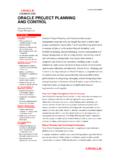Transcription of 19. STRUCTURED TEXT PROGRAMMING - infoPLC
1 32919. STRUCTURED TEXT INTRODUCTIONIf you know how to program in any high level language, such as Basic or C, you will be com-fortable with STRUCTURED Text (ST) PROGRAMMING . ST PROGRAMMING is part of the IEC 61131 standard. An example program is shown in Figure 261. The program is called main and is defined between the statements PROGRAM and END_PROGRAM. Every program begins with statements the define the variables. In this case the variable i is defined to be an integer. The program follows the variable decla-rations. This program counts from 0 to 10 with a loop. When the example program starts the value of integer memory i will be set to zero. The REPEAT and END_REPEAT statements define the loop.
2 The UNTIL statement defines when the loop must end. A line is present to increment the value of i for each 261A STRUCTURED Text Example ProgramOne important difference between ST and traditional PROGRAMMING languages is the nature of Topics:Objectives: To be able to write functions in STRUCTURED Text programs To understand the parallels between Ladder Logic and STRUCTURED Text To understand differences between Allen Bradley and the standard Basic language structure and syntax Variables, functions, values Program flow commands and structures Function names Program ExamplePROGRAM mainVA Ri : INT;END_VARi := 0;REPEATi := i + 1;UNTIL i >= 10;END_REPEAT.
3 END_PROGRAMNote: Allen Bradley does not implement the standard so that the programs can be written with text only. When program-ming in RSLogix, only the section indi-cated to the left would be entered. The variable i would be defined as a tag, and the program would be defined as a flow control. A ST program will be run from beginning to end many times each second. A tra-ditional program should not reach the end until it is completely finished. In the previous example the loop could lead to a program that (with some modification) might go into an infinite loop. If this were to happen during a control application the controller would stop responding, the process might become dangerous, and the controller watchdog timer would force a has been designed to work with the other PLC PROGRAMMING languages.
4 For example, a lad-der logic program can call a STRUCTURED text THE LANGUAGEThe language is composed of written statements separated by semicolons. The statements use predefined statements and program subroutines to change variables. The variables can be explicitly defined values, internally stored variables, or inputs and outputs. Spaces can be used to separate state-ments and variables, although they are not often necessary. STRUCTURED text is not case sensitive, but it can be useful to make variables lower case, and make statements upper case. Indenting and comments should also be used to increase readability and documents the program. Consider the example shown in Figure 262A Syntax and STRUCTURED PROGRAMMING ExampleFUNCTION sampleINPUT_VARstart : BOOL; (* a NO start input *)stop : BOOL; (* a NC stop input *)END_VAROUTPUT_VARmotor : BOOL;(* a motor control relay *)END_VARmotor := (motor + start) * stop;(* get the motor output *)END_FUNCTIONGOODBADFUNCTION sampleINPUT_VARSTART:BOOL;STOP:BOOL;END_ VAROUTPUT_VARMOTOR:BOOL;END_VAR MOTOR:=(MOTOR+START)*STOP; Elements of the LanguageST programs allow named variables to be defined.
5 This is similar to the use of symbols when PROGRAMMING in ladder logic. When selecting variable names they must begin with a letter, but after that they can include combinations of letters, numbers, and some symbols such as _ . Variable names are not case sensitive and can include any combination of upper and lower case letters. Variable names must also be the same as other key words in the system as shown in Figure 263. In addition, these vari-able must not have the same name as predefined functions, or user defined 263 Acceptable Variable NamesWhen defining variables one of the declarations in Figure 264 can be used. These define the scope of the variables.
6 The VAR_INPUT, VAR_OUTPUT and VA R _I N_ O UT declarations are used for variables that are passed as arguments to the program or function. The RETAIN declaration is used to retain a variable value, even when the PLC power has been cycled. This is similar to a latch application. As mentioned before these are not used when writing Allen Bradley programs, but they are used when defining tags to be used by the STRUCTURED 264 Variable DeclarationsExamples of variable declarations are given in Figure 265. Invalid variable names: START, DATA, PROJECT, SFC, SFC2, LADDER, I/O, ASCII, CAR, FORCE, PLC2, CONFIG, INC, ALL, YES, NO, STRUCTURED TEXTV alid memory/variable name examples: TESTER, I, I:000, I:000/00, T4:0, T4.
7 0/DN, T4 RVA R _ I N P U TVAR_OUTPUTVAR_IN_OUTVAR_EXTERNALVAR_GLO BALVAR_ACCESSRETAINCONSTANTATEND_VARD escriptionthe general variable declarationdefines a variable list for a functiondefines output variables from a functiondefines variable that are both inputs and outputs from a functiona global variablea value will be retained when the power is cycleda value that cannot be changedcan tie a variable to a specific location in memory (without this vari-able locations are chosen by the compilermarks the end of a variable declaration332 Figure 265 Variable Declaration ExamplesBasic numbers are shown in Figure 266. Note the underline _ can be ignored, it can be used to break up long numbers, ie.)
8 10_000 = 10000. These are the literal values discussed for Ladder 266 Literal Number ExamplesCharacter strings defined as shown in Figure Program LineVAR AT %B3:0 : WORD; END_VARVAR AT %N7:0 : INT; END_VARVAR RETAIN AT %O:000 : WORD ; END_VARVAR_GLOBAL A AT %I:000/00 : BOOL ; END_VARVAR_GLOBAL A AT %N7:0 : INT ; END_VARVAR A AT %F8:0 : ARRAY [ ] OF REAL; END_VARVAR A : BOOL; END_VARVAR A, B, C : INT ; END_VARVAR A : STRING[10] ; END_VARVAR A : ARRAY[ , , ] OF INT; END_VARVAR RETAIN RTBT A : ARRAY[ , ] OF INT; END_VARVAR A : B; END_VARVAR CONSTANT A : REAL := ; END_VARVAR A AT %N7:0 : INT := 55; END_VARVAR A : ARRAY[ ] OF INT := [5(3)]; END_VARVAR A : STRING[10] := test ; END_VARVAR A : ARRAY[ ] OF BOOL := [1,0,1]; END_VARVAR A : ARRAY[ , ] OF INT := [5(1),5(2)].
9 END_VARD escriptiona word in bit memoryan integer in integer memorymakes output bits retentivevariable A as input bitvariable A as an integeran array A of 15 real valuesa boolean variable A integers variables A , B , C a string A of length 10a 5x6x7 array A of integersa 5x6 array of integers, filled with zeros after power off A is data type B a constant value A A starts with 55 A starts with 3 in all 5 spots A contains test initiallyan array of bitsan array of integers filled with 1 for [0,x] and 2 for [1,x]number typeintegersreal numbersreal with exponentsbinary numbersoctal numbershexadecimal numbersbooleanexamples-100, 0, 100, , , , , , , #111111111, 2#1111_1111, 2#1111_1101_0110_01018#123, 8#777, 8#1416#FF, 16#ff, 16#9a, 16#010, FALSE, 1, TRUE333 Figure 267 Character String DataBasic time and date values are described in Figure 268 and Figure 269.
10 Although it should be noted that for ControlLogix the GSV function is used to get the 268 Time Duration ExamplesFigure 269 Time and Date ExamplesThe math functions available for STRUCTURED text programs are listed in Figure 270. It is worth noting that these functions match the structure of those available for ladder logic. Other, more advanced, functions are also available - a general rule of thumb is if a function is available in one lan-guage, it is often available for , a , $ , $$ $R$L , $r$l , $0D$0A $P , $p $T , 4t this%Tis a test$R$L descriptiona zero length stringa single character, a space, or a , or a single quote, or a dollar sign $produces ASCII CR, LF combination - end of line charactersform feed, will go to the top of the next pagetaba string that results in this<TAB>is a test<NEXT LINE> Time , 5hours, 6min, 36secExamplesT#25ms, T# , TIME# , T#-25ms, t#25msTIME# , T# , T#5h_30m, T#5h30mTIME#3d5h6m36s.














